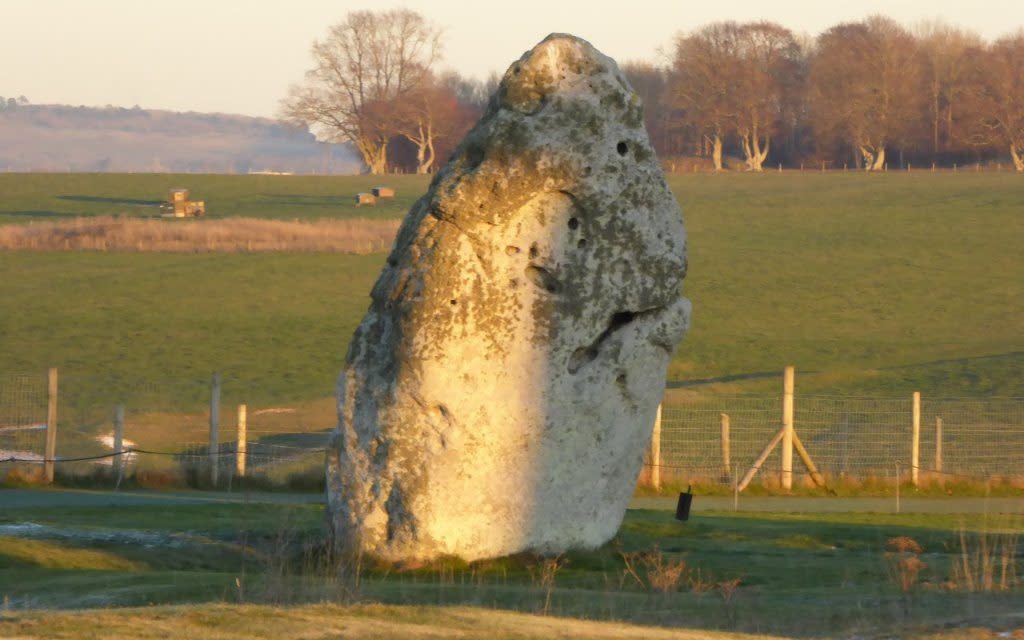Winter solstice sunset was crucial Stonehenge date for ancient Britons, not famous sunrise, say experts

- Oops!Something went wrong.Please try again later.
Thousands of people gather every June to mark the longest day of the year by watching the Sun rise at Stonehenge.
But according to archaeologists, it is sunset on the winter solstice, which takes place this week, that was more important to ancient Britons, commemorating the turning of the year and a welcome end to the ever-darkening days.
Stonehenge channels the final rays of the setting solstice Sun through the giant sarsen trilithons, illuminating the Heel Stone, which stands roughly 250ft from the centre of the circle.
Barring a cloudy sky, the phenomenon will happen on Friday Dec 22, at around 4pm.
However, English Heritage, which manages Stonehenge, this week invited visitors to celebrate the winter solstice at sunrise on Dec 22, meaning most would have been looking too early, and in the wrong direction.
A Neolithic ceremonial procession
Experts believe that during the Neolithic age, large numbers of people would have processed along a ceremonial pathway on Salisbury Plain known as The Avenue on the winter solstice to watch the Sun slowly setting in the south west.
Prof Clive Ruggles, an authority on archaeoastronomy and Stonehenge, said: “The main reason for believing that the winter solstice sunset, rather than the summer solstice sunrise, was the more important event at Stonehenge is that the formal, ceremonial approach to the monument, along the straight section of The Avenue from the north east, is towards that direction.
“Someone progressing slowly up The Avenue prior to sunset around the time of winter solstice would have seen the Sun gradually descending towards the Stones ahead of them, whereas someone approaching before dawn on the summer solstice would have had to reach the monument and then turn round in order to see the sunrise.”
Prof Ruggles, the co-author with Amanda Chadburn of the book Stonehenge – Sighting the Sun, added: “The stones beside the solstitial axis were dressed finely on the sides that one would see when approaching the monument from The Avenue, whereas their backs were often poorly shaped or not shaped at all.
“This again suggests that the most important event took place when people were facing the south west, not turning round to look north east [the direction of the summer solstice sunrise].”
The winter solstice effect was captured last year by Telegraph reader Andrew Butler, who believes the phenomenon would be clearer if trees were removed at Normanton Gorse to restore the original path of the light.
Care for solstice sightlines
Currently, the light that hits the Heel Stone is skewed to the left and vanishes before the real sunset.
“The low trajectory of the winter setting Sun, combined with the trees of Normanton Gorse on the horizon, causes the sunset illumination not only to disappear early, 10 minutes before sunset, but to be shifted sideways to the west,” Mr Butler said.
“Last December I was the only person at Stonehenge looking the right way at the right time. It is time that the midwinter sunset alignment of Stonehenge was taken seriously.”
Prof Ruggles, the emeritus professor of archaeoastronomy at the University of Leicester, agreed that clearing the 2.5-mile sightline would “certainly help”.
“This and other solstitial sightlines through the landscape within the Stonehenge World Heritage Site are attributes that contribute to its ‘outstanding universal value’ as recognised by Unesco, and so we do need to care for them,” he said.
The origins of Stonehenge have baffled historians for hundreds of years. In 1100, Geoffrey of Monmouth wrote that Merlin had constructed the monument, while in 1640, philosopher John Aubrey declared it the work of the druids.
In 1655, John Webb, the architect, claimed Stonehenge was a Roman temple to the sky god Caelus, and it was not until the advent of radiocarbon dating that it was proven to be far older – dating from 3100 BC and constructed by early farmers who had migrated from Central Europe.
Winter months of feasting
The megalith sits within a large ceremonial landscape, which includes the super henge at Durrington Walls which acted as a sacred meeting spot and settlement.
Mike Parker Pearson, the professor of British later prehistory at University College London, said: “It has been known for a very long time that the great trilithon framed the midwinter solstice sunset since it is 180 degrees opposite to the midsummer sunrise.
“The winter months were the main period of feasting at the nearby settlement of Durrington Walls. We know that people lived there all year round (from pig slaughter patterns from ageing of their teeth) but winter was the key period for large numbers gathering in the Stonehenge area.”

